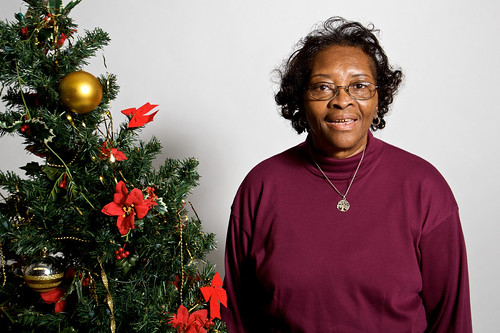 DC is a few days away from a new fee on grocery bags. At five cents, this fee won't be noticed by many. And it applies only to vendors -- not places like food pantries -- so it doesn't impact Bread for the City's bottom line.
DC is a few days away from a new fee on grocery bags. At five cents, this fee won't be noticed by many. And it applies only to vendors -- not places like food pantries -- so it doesn't impact Bread for the City's bottom line.
But that's not the case for our clients. For people with an average annual income of less than $7,000, these fees will certainly add up.
Since the bill was introduced, we've been speaking with city officials about serving as a key distribution center for a supply of reusable bags. So far we've received some small sets of bags, and we're scheduled to receive more supplies from the city in the coming weeks.
That said, reports are coming in that there are going to be far fewer bags than originally promised. See this news feature filed by Tom Sherwood (featuring your humble blog editor):
We support efforts to reduce waste and clean up our community's environment -- but it is also critically important at this point in time to reduce the impact of such efforts on those who can least afford it!
In the meantime, private donors have begun to rise to the occasion -- like Michael Wagner of Promo-Vision, who saw the above television report and promptly donated a large supply of sturdy bags. Many thanks to Promo-Vision for their generosity! 
If you have a supply of reusable bags, you can donate them to either center during standard business hours. Thank you!
December 30, 2009
Bagging it!
December 29, 2009
Legal services: expanding amidst recession
A recent Washington Post editorial described the challenges District residents face in finding legal help on a variety of issues, including securing food stamps. The editorial quotes a report by the DC Access to Justice Coalition that finds the recession to be severely impacting the civil legal services sector: "Programs report losing more than 25% in revenue and have shed approximately 12.5% of their lawyers and nearly 40% of non-lawyer staff, including paralegals, social workers, case managers and administrative support."
While there is definitely a scarcity of legal service providers for low-income Washingtonians, Bread for the City would like to note that we have recently expanded our capacity to provide legal assistance with public benefits.
For instance: Stacy Braverman joined our legal clinic in September, through an Equal Justice Works fellowship funded by the Sutherland law firm. She has been helping clients receive the appropriate level of food stamps and other public benefits, such as Temporary Assistance to Needy Families (TANF), medical assistance, Interim Disability Assistance, and child care subsidies. Alongside Su Sie Ju and Allison Miles-Lee, Bread for the City staff attorneys who also work on these types of public benefits cases, Stacy has reviewed clients' case files, represented clients at fair hearings, accompanied them on visits to Income Maintenance Administration (IMA) service centers, and recovered thousands of dollars in benefits to which our clients are entitled.
To give you a sense of how this all works and why it's important, we asked Stacy to share a couple of stories:
After being homeless, Mr. L had found an apartment, was being treated for his disability, and was helping raise and support his son. The $16 a month in food stamps he received did not go far. Mr. L had money withheld from his disability check each month, and the IMA's rules on food stamp calculations did not cover his specific situation. In addition, IMA was not factoring the child support Mr. L paid into their determination of his food stamp benefit. We worked with IMA's policy analysts and with staff at Mr. L's service center to make sure they calculated his benefits properly, and now he will receive $84 each month. In the week before Christmas, Mr. L also received several hundred dollars in food stamps he had been entitled to but had never received.Also:
After Ms. S lost her job, she was told, incorrectly, that she didn't qualify for TANF because one of her two children received disability benefits. Bread for the City's food program provided groceries, its social services program gave referrals for children's clothing, and our legal clinic spoke with several IMA supervisors and helped Ms. S advocate for herself at the service center. Her household now receives $270 a month in TANF, which provides a crucial safety net while she searches for employment.Stacy is reaching out to BFC's other program areas, and to other service providers throughout D.C., in search of more people who may need advice or assistance on public benefits matters. She can be reached at (202) 386-7077 or sbraverman@breadforthecity.org.
Thanks to Stacy and Allison Miles-Lee for assistance with this post.
December 25, 2009
So many "thank you"s
As we enjoy this holiday with our families, let's also take a moment to highlight some of the remarkable supporters in the Bread for the City community.
For instance, the Washington Post's Steven Pearlstein -- in his annual column about the year's best corporate philanthropy -- gave special recognition to WilmerHale for the law firm's fantastic support of Bread for the City, as well as to DLA Piper!. Thanks to Steven, and a huge thanks to WilmerHale and DLA Piper! (Read more coverage of WilmerHale's work with us here and DLA Piper's work here.)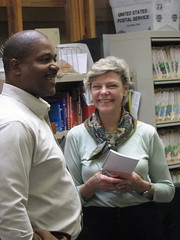
Also prominent: Cokie Roberts came to visit us during Holiday Helpings, took a tour of our facility and asked some great questions about how it all works, and then wrote a thoughtful column about hunger in America. See pictures of her visit here.
I'd also like to take a moment to acknowledge some remarkable contributions from individuals you haven't heard of before:
Nick L. Bennett, for instance, has made a generous contribution to Bread for the City for the past ten years. It's always a different number, always in uneven amounts. Here's how he calculates his giving: while riding his bike to work each day, he would stop to pick up any coins he saw on the roadway. At the end of the year, he would multiply the sum of those coins by 100, and write a check for that amount to Bread for the City. He said he did this in recognition of what a lucky man he was.
A few years ago Mr. Bennett had a brain aneurysm, and ceased biking. But still today he finds coins while walking, and at the end of the year still makes a check out to Bread for the City for 100 times the amount. Thank you for this remarkable gesture, Mr. Bennett.
[Thanks to Colonel Joel Gardner for this story.]
And finally, Frederick Scott came to Bread for the City while on a field trip to DC with his church group. Fred helped us out in the food pantry for an afternoon, and apparently we impressed him, because he subsequently made a video about us, hosted a bake sale at his school to raise money, and then brought his mother with him for a second volunteer session. Here's the kicker: Rick is from Massachusetts! He and his mom took a special train trip all the way down to DC just to volunteer at Bread for the City, because he was so taken with our work.
Says Rick:
The small gestures and acts of kindness from my school's community back home made this trip possible. They showed me how a "community" can gather and achieve something great. I see it at home, I see at Bread for the City, and someday I imagine seeing it all over the world."Rick made another lovely video after his second trip:
Thank you, Rick and all of our supporters. Your support makes such a difference! Happy holidays to all.
December 24, 2009
Photo Shoot! Staff Struts Stuff
During our holiday photo shoot (see the first two installments here and here) we encouraged staff and volunteers to join in for some peppermint glamour shots. After a long day of work, some staff were more excited than others about posing for the camera - but all the photos came out beautifully! [See more at our Flickr feed here.]
Wendy & Jo work in our Social Services department. Wendy is a Licensed Graduate Social Worker and Jo is a Case Manager for our Representative Payee clients. Jo came to us originally through a year of service with Lutheran Volunteer Corps but has recently accepted a salaried staff position!
Dr. Joan E Myles is one of Bread for the City's two physicians. She is a big fan of family portraits – this is her family’s second year in a row (this time with a guest!). She and her husband, Seiji, made a generous donation that is funding the prints from this photo shoot that we sent to our clients. Thank you, Joan E!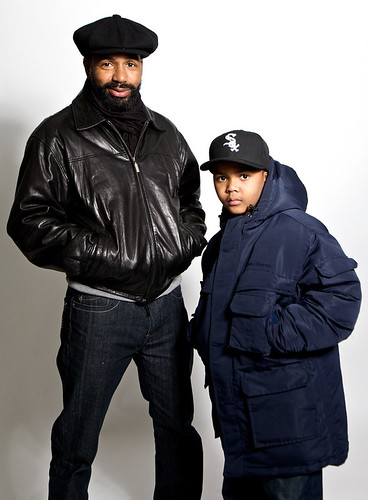
Stacey Smith, seen here with his son Solace, is a Case Manager in our Social Services department and coordinator of our Pre-Employment Program. Read his story here.
Susanne with her partner Monica and son, Danny, manages our Representative Payee Program for both centers. Just days later, Susanne welcomed her newborn, Ben, into the world!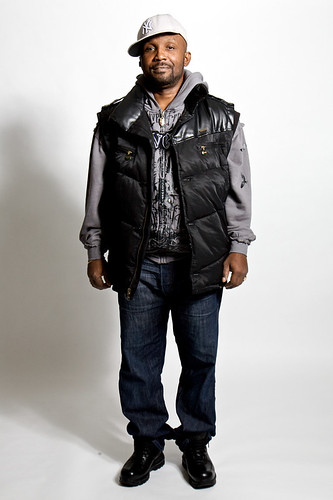
Tony coordinates our Southeast food pantry, where 100+ people come to pick up food every day. Thanks, T!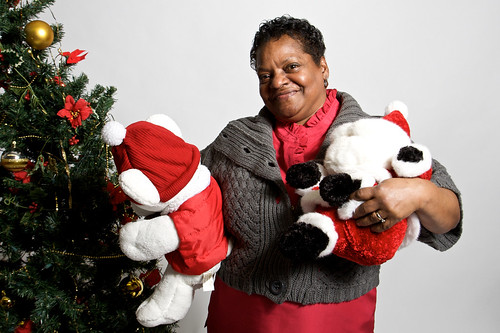
Mrs. Ford manages our clothing bank in Southeast -- entirely as a volunteer! This year, Mrs. Ford got married and we are thrilled for her.
Again, huge thanks to Steve Goldenberg for the ace photography. (See his full sets here and here.)
And thanks to Julia Eddy for co-authoring this post.
December 23, 2009
Photo Shoot! Holiday Portraits Too
Free printed portraits are currently making their way through the mail to our participating clients - a great way to give these families some special holiday cheer. See the full sets here and here. (Many thanks to our good friend Steve Goldenberg for making it all happen!)

Susan Berger: "I was misdiagnosed so many times before they discovered that I had MS. It was giving me such trouble at work, where I was a technical training manager at Cablevision. So of course I lost job and my insurance -- and came here. That was almost 17 years ago!
Since then, this has been where I go first to get help. I've seen the best and I've seen the worst - and Bread for the City is better than any hospital. Bread for the City helped me even get my Social Security Disability Insurance, after I'd been denied. Could you believe they'd deny someone with MS? Well you helped fix that.
Now I'm a full-time student at the Art Institute in Rosslyn. I look forward to working with you all."
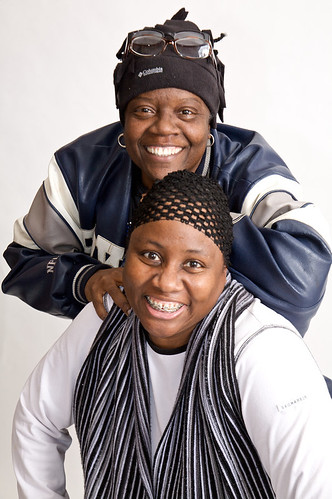
Gloria Berger (Susan's sister): "I received legal assistance from you all during my divorce. I was trying to keep my house and I didn't know what legal rights I had -- I was hearing all kinds of things and didn't know what to do. Bread for the City lawyers helped me figure out what I needed to get started. Recently, I've come back here for information about job training programs."

Gerald Clark uses our resource center to find employment leads, and receives referrals from our medical clinic. In the past, he's worked as a medical correspondent at Walter Reed, a cook, and a laborer with Clark Construction.
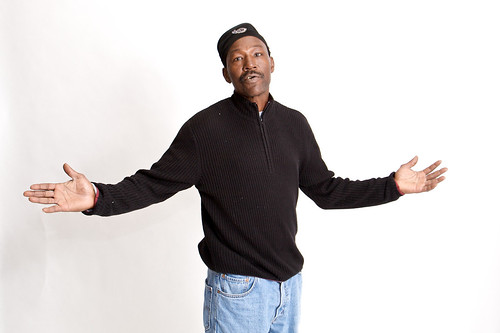
We provided Jeremiah Clark with assistance in attaining Medicaid.
December 22, 2009
Photo Shoot! Holiday Hammings Edition
Free printed portraits are currently making their way through the mail to our participating clients - a great way to give these families some special holiday cheer. See the full sets here and here. (Many thanks to our good friend Steve Goldenberg for making it all happen!)
Here some of our favorites below:
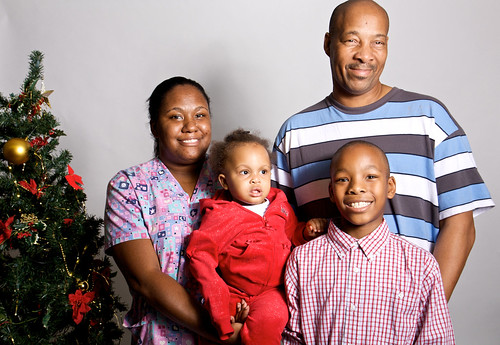
Mr. Rivers, pictured here with his wife and two children, was a Metro driver for many years, and now receives disability assistance. Bread for the City helps his family with food and things like utility bills. Natasha (on left) is enrolled in a local technical college.

Monique and her daughters are regulars at our clothing room, and appear here in two sets of wardrobes assembled entirely from the "BFC Boutique," as it's known.
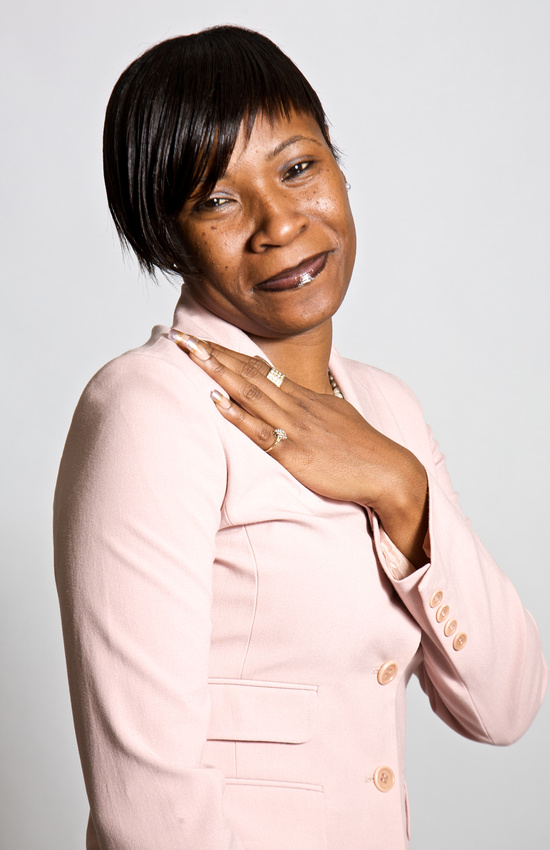
Maya:

Monique received Temporary Assistance for Needy Families for around a year, before moving on to self-sufficiency. About that transition, she says simply: "you must be motivated to make it happen." To that end, she credits Bread for the City for supporting her: "It's my resource base. If I need to get something to happen, I can always start here."
Bread for the City helped her find resources to enroll in school and finance her education. Today, she is studying for her Licensed Practical Nurse degree. (Her school wardrobe has come almost entirely from our clothing room.)
"When I walk out of Bread for the City, I feel like I'm in control."

Hattie says "the economy brought me here." Bread for the City helps supplement her medical expenses.
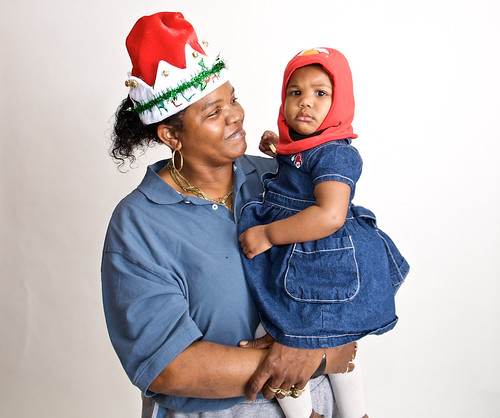
Thelma, pictured here with Shanise, one of her four grandchildren: "I live just down the street been here forever. I was here when y'all were building this place! It's a great help to the community. I used to donate clothes here. Now I sometimes need to come by for food and clothing myself. Ah, don't worry about Shanise - she makes that face at everyone."
December 17, 2009
Holiday Helpings - ONE WEEK TO GO!

Of course, we couldn't have made it this far without the generous support from our community through food drives, corporate sponsorships, and individual giving. In fact, one recent partnership was with Caron Butler of the Washington Wizards.
For a second straight year, Bread for the City was asked to be a part of Caron Butler's annual 3D Holiday Basketball Classic Tournament. The canned food drive that was a part of this event brought in not only some much-needed items for our Holiday 
Check out Caron Butler with one of our youngest volunteers, DJ (left) and Antawn Jamison and Bread for the City's truck driver, George (right)!
Obviously, you don't have to be a 7-foot-tall professional basketball player to make the holidays brighter for our neighbors who struggle daily with poverty. Just $28 can provide a family of four with a holiday meal — a turkey and all the trimmings. Give today!
December 16, 2009
Cooking Class Kickoff
On Monday, December 14, we kicked off a new cooking class at Bread For the City’s Southeast Office. The Northwest cooking class has been well underway, and now we’ve taken the maiden voyage to start one up on Good Hope Road. We had a grand time making delicious, healthy, and easy Mediterranean food. Sharon Gruber, our Nutrition Consultant, taught us how to make Greek salad, Syrian rice and lentil mujadara, and carrots in orange sauce.
Before we started cooking, Sharon taught us a bit about whole grain versus white products. In the process of turning whole grains to white grains, a vast majority of the nutrients, vitamins, and minerals are lost. For instance, 75 percent of the iron in wheat is in the germ and bran, both of which are removed in the process of making whole grains into “white” products. And this is why Sharon made sure that the rice we cooked was whole grain, so we can get what our body needs. A common complaint about cooking brown rice is that it takes too long, but Sharon suggested that you can submerge the rice in water the night or morning before you plan to cook it, and by the time you’re ready to start dinner, it’ll only take 20 minutes.
Throughout the class, we all learned a number of helpful tidbits about various foods, such as grating a little lemon zest onto your salad, which helps the liver with its detoxification process. We were reminded not to peel off the cucumber skin as we chop it up for the salad, because the skin is full of nutrients. Even each of the spices and garnishes we added to the carrots had an important health component: cinnamon slows the release of sugar in the blood (great for diabetes), cumin is good for the heart, and parsley—and anything green—is good for the blood.
As we sat down to the meal, we devoured the delicious food and had enough to share with staff at the Southeast Office, enjoying a delicious family dinner. Sharon reminded us to listen to when we feel satisfied, not full. It’s all too easy to go over the threshold that our body needs, especially when the food is so good. Needless to say, we all had seconds on the carrots and salad, which disappeared quite quickly!
Each of the participants was delighted with the meal. “The carrots would be a good holiday dish. I can take them to a potluck,” mentioned Linda H. Diane stated, “I like to learn about good ways to fix foods I can eat that are good for me, because I eat a lot of foods that aren’t so good.” We’re hopeful that the class can be a learning experience for all of us as we continue to improve our eating habits. Every time I attend a class, I surely learn an abundance of new health information! We look forward to continuing the program as we begin to become stronger advocates for healthy living within the communities we serve.
Here’s the ingredient list if you’re interested in trying these delicious recipes for yourself!
Greek Salad
-Romaine lettuce
-Feta Cheese
-Tomato
-Cucumber
-Onion
-Lemon (juice squeezed for dressing, grated zest/peel for garnish)
-Olive oil (dressing)
Syrian Mujadara
-Brown rice (twice as much rice as lentils)
-Cinnamon
-Lentils
-Onions
Carrots in Orange Sauce
-Baby carrots
-Orange juice
-Cinnamon
-Paprika
-Cumin
-Fresh parsley (chopped in at the end for flavor/garnish)
December 14, 2009
Ted Pringle: Man of the Year
I bring great news: Bread for the City's longtime Food & Clothing Director Ted Pringle has received the Linowes Leadership award (presented by the Community Foundation of the National Capital Area) for his many years of service to our community.
When Ted received the award last week, he had this to say to the crowd: "It's just amazing to me to get an award for doing the work you love to do."
For 17 years now Ted has been working behind the scenes, quietly building the food program from serving 300-400 clients per month to nearly 10,000 each month. While those numbers are impressive, I don't think they truly convey Ted's impact on the community.
When I reflect on all that Ted has accomplished, I cannot help but think of Brian, a developmentally delayed, nearly mute adult in his 40s who volunteers every day in our Southeast Center food pantry. Choking back tears, Brian's father recently gave thanks for Ted when sharing just how much working in the food pantry means to his son.
Despite a hectic schedule that includes placing food orders, coordinating deliveries, and managing staff and volunteers at two locations, Ted exhibits the utmost patience and compassion with Brian and his fellow volunteers from St. John's Community Services, making sure they feel at home and giving them meaningful jobs to do each day. With this simple gesture, Ted gives Brian and others like him a sense of responsibility when so many others might not. By entrusting Brian with the task of filling food bags and breaking down boxes, Ted gave Brian a role within our organization.
As part of his award Ted received $3,000 to donate to the charity of his choice. Naturally, Ted has chosen Bread for the City -- but he makes this choice with a request to our donors: will you help match Ted's award, dollar for dollar?
Let's join with the Community Foundation in showing Ted how much he means to us: make a gift to Bread for the City today in his honor, and in honor of the incredible growth of our pantry.
You are also encouraged to leave a note to Ted in the comment box, or to send him your own personal message at TPringle@BreadfortheCity.org.
Put Our Money Where Our Mouths Should Be
[Cross-posted from the DC Food For All.]
I have a view on fresh produce that might not shock you: Everyone should be able to buy it.
But for many low-income folks, that option doesn’t exist. The cost is simply too high. As Bread for the City's nutrition consultant, many of my patients tell me that money is the leading reason they don’t make healthier choices. They're happy to receive the fresh produce that Bread for the City now includes in every bag. But that only covers a few days out of the month. When they have to shop for the rest, they find ready-to-eat meals, fast food, soda, snacks, and corn- and grain-fed beef and pork to be downright cheap when compared to fruits and vegetables.
Does it have to be this way?
Consider that the government already plays a role in making some crops plentiful and cheap; wheat, soy, and corn are all heavily subsidized. And since those subsidies are substantial, some farmers are encouraged to plant more of them and less fruits and vegetables. This is part of why fresh produce seems out of reach at the market for many, and grocery carts are instead stuffed with the cheap products derived from wheat, soy, and corn. These days it truly takes a vigilant consumer to avoid the omnipresent high-fructose corn syrup, partially hydrogenated soy and corn oil, and additional fat from cattle and pigs that survive on inexpensive corn and grain-based feed.
 Flickr credit: frederikvanroest/ / CC BY 2.0
Flickr credit: frederikvanroest/ / CC BY 2.0
Why not level the playing field a bit more? What about subsidizing produce like broccoli, watermelon, and garlic? Or what about bulk government purchasing of these foods, an approach many farmers prefer? Imagine if fresh peaches were a true price-point alternative to peach Fruit Roll-Ups. It would cost money, for sure, but it could also have a significant impact on the dignity, health (and health-care costs) of lower-income folks who otherwise wouldn’t be able to afford it.
 Claggett Farm - http://www.flickr.com/photos/galant/ / CC BY 2.0
Claggett Farm - http://www.flickr.com/photos/galant/ / CC BY 2.0
Now check this out: The agricultural subsidies are passed by Congress in the same bill as food stamp funding. Some experts say that the farm lobby pushes hard to keep the two connected, as politicians are less likely to cut subsidies if almost 34 million people in need are depending on the bill’s passage.
So essentially, the current distribution method of agricultural subsidies affects the health issues of our country’s low-income citizens. Yet subsidy funding persists, in part, because of the needs of those same low-income citizens. Ouch.
Agriculture subsidies are a pretty controversial topic in public health and agriculture policy circles. I won’t pretend to get it all right in this post, but I do intend to invite more discussion.
What do you think?
December 10, 2009
What the Dickens!

A few weeks back, we were contacted by the good folks at Ford's Theatre. They wanted to partner with Bread for the City around their running of A Christmas Carol.
Well, as it turns out, the partnership proved to be tremendously successful. With both internal and external campaigns, Ford's Theatre raised nearly $13,000 — all to benefit Holiday Helpings. (That adds up to 460 healthful holiday meals!)
Here's the best part. When the Ford's Theatre reps stopped by Bread for the City this week to present us with this donation, they gave it to us in cold, hard, sweet cash. They came to us with a black canvas bag filled to the brim with $13K worth of ones, fives, tens, a few twenties, and one fifty dollar bill inside. (We are also relieved to note that the cash was very neatly organized and VERY accurately counted.)
This was the largest, one-time hard-cash donation that Bread for the City has ever received. We couldn't resist stacking the money in big stacks, Scrooge-like, for a photo shoot.
We most definitely agree with Paul Tetreault, Director of the Ford's Theatre Society when he said:
It is truly fitting that we reflect the messages of charity, hope and love found in Dickens's A Christmas Carol by addressing the needs within our own communities.
So how about you? Are you waiting to be visited by mythical, time-traveling ghosts before getting involved in helping those in need? It would be a lot easier to just click here to join Holiday Helpings today!
True, money can't buy happiness. But just $28 can provide a family of four with a celebratory meal. Give today!
December 9, 2009
Best Pantry Practices
Bread for the City recently participated in a nationwide study about this question. Graduate students enrolled in Kaplan University’s online School of Business and Management reviewed many food pantries to compile a best practice toolkit [PDF!] made available through Feeding America.
The report lists 12 best practices, ranging from Provide Clear Organization Chart and Project Guidelines, to Plan for the Year. Here at Bread for the City, we have our own quirky ways of getting things done -- but we were pleased to note that our program already practices most of the best practices mentioned within the project.
For instance, right now we're in the midst of Holiday Helpings, when our food pantry is in overdrive. We have Planned for the Peak Season by arranging for food well in advance and putting our volunteer coordinator, Erin Garnaas-Holmes, on serious work-horse duty to line up the large numbers of volunteers that this season requires. This year we also opened the pantry up to the media and the public, with guests such as Cokie Roberts, Leon Harris and Yvette Alexander. The best practice guide also helpfully suggests that food pantries Motivate Staff, and we have duly celebrated Food Pantry Staff Appreciation Month, with a flood of emails, gifts, and cards to our pantry staff from all other departments.
Many non-profits have a strained relationship between the need to be “businesslike” with efficiency and their commitment to the needs of community members. This report sticks to strictly the businesslike efficiency side of food bank and food pantry affairs. Here at Bread for the City, however, I've noticed that this gives you an incomplete picture of what makes a food pantry great.
When I asked Jenette Chance, the Northwest Food Coordinator, about efficiency in the food pantry, her response centered right back on the community. “I know what it is to be hungry. My everything is in it. So I make it smooth for people to come in and go out, and I acknowledge everyone. We're all working together to build a better Bread for the City from the inside out.” Best practices and efficiency are important, but more important is respect and dignity. Perhaps this is a best practice of its own.
Developing these relationships also allows us to delve deeper into the best practice of Educate the Public. The report notes the importance of informing donors, volunteers, and clients about the program. However, at Bread we have also started to think beyond publicity to how we can help our clients make healthy decisions, through fliers, cooking classes, and other means. This can be summed up in another best practice: Envision a Better World. Let’s all dream about how we can best serve our communities.
December 8, 2009
Finding self-worth in the face of homelessness and hunger
[Louise Thundercloud is a familiar face here at Bread for the City, and an active community member engaged in various efforts for progressive change. Louise submitted this post to the DC Food For All, and we're pleased to cross-post it here. —ed]
As the definition of what constitutes a homeless person evolves and changes—widening to include those who house-sit, those who live in friends’ spare rooms, or basements, or cars, or hotels, etc – I think solutions to some of the very nasty by-products of homelessness need to be found.
The most odious problem is hunger – more importantly, hunger that limits the scope of your choices of what to eat. This issue is related to the problem of very low self esteem: feeling as though you deserve only what is given to you, because you feel so terrible about yourself. I am referring to the lack of empowerment felt by most homeless people, & it compounds when someone had very low self esteem prior to becoming homeless. 
When I began my climb out of being homeless, I began to get very angry at my lack of control over the more basic things, what I ate. I began to refuse to eat, preferring to sleep away hunger.
Hunger is the manifestation that accompanies having no job, and being completely dependent on others for food. What if the homeless had other choices, which include fresh organic vegetable or fruits, that they can earn in exchange for volunteering their time at a health food store or urban garden?
Someone told me about a food co-op which would allow me to volunteer & use my volunteer hours to purchase organic fresh foods. On my first shift I felt myself feeling more capable & less at the mercy of others. I had choices & my work gave me those choices.
Fortunately for me, I did not become homeless with a lot of the baggage many do, I didn’t have completely crushed self-esteem, just interrupted self-worth.
Homelessness strips you bare of your humanity. You feel like scum. You often look like scum, & people generally either do not notice you, or they do with malice & disgust. Negativity is very easily absorbed & once it has been absorbed, it is very hard to shake, especially when you are homeless.
So here’s my question: since low self-esteem leads to repeat homeless, shouldn’t self-esteem building be offered more often to end the cycle of homeless? Where food is concerned, couldn’t more opportunities be aimed directly at the homeless community in the form of shift work, enabling the person to earn groceries they want & are able to fix themselves, thereby providing an avenue for empowerment?
Having worked several times as a volunteer at a health food store, I know how busy things get. Having more able bodied volunteers would enable to permanent staff more time to take care of their customers. Also shift work allowed me to learn about different movements: human rights, environmental, peace movements. Other kinds of connections can be made, as well as other solutions can be found for ending some very perplexing problems. Perhaps ending homelessness could be one of them.
The homeless can play a large role in addressing hunger in the homeless community, & open a dialogue on how homeless people can play a large part in ending the cycle of homeless & low self –esteem in their community.
Isn’t it empowering to feed oneself what one wants, instead of having to eat what is put in front of you, particularly food that you really don’t want to eat? I know that having that choice put self-determination & empowerment in my hands.
Louise Thundercloud
Homeless 1991-1993
December 7, 2009
Yvette Alexander comes for Holiday Helpings

Folks coming to our Southeast Center were happy to see Councilwoman Alexander and were eager to share with her their stories and experiences. She listened intently as she learned her way around our bustling food pantry during our busiest time of the year.
Although this was the first time that Yvette Alexander has visited Bread for the City, she was certainly moved by what she saw. Not everyone visiting our food pantry that day was there to pick up a Holiday Helpings meal for their own family. One man in particular, came to Bread for the City that day to pick up a turkey dinner not for himself, but for his elderly neighbor - a neighbor who would otherwise have been unable to carry his meal home. Councilwoman Alexander left promising to return again in the near future. We're looking forward to it!
To date, Bread for the City's 2009 Holiday Helpings campaign has provided more than 5,500 families with the luxury of a holiday meal—a turkey & all the trimmings. With just three weeks left in the campaign, we have 3,000 more Holiday Helpings meals to go to meet our goal of feeding 8,500 families this holiday season. It is certainly not too late to get involved. Join Holiday Helpings today!
December 4, 2009
Perfectly Bruised Produce
In my time as coordinator of the Glean for the City program, I witnessed many ways in which our food system is shaped by human biases about food that often have nothing to do with taste or nutrition.
In general, consumers demand aesthetically perfect produce. We toss pears back if they have a small bruise. Melons with any softness are left to rot at the bottom of produce displays. Shoppers feel that bruising and physical imperfections indicate poor taste.
 This negative perception extends even to the fields. When people go to farms to pick their own apples, they are reluctant to harvest directly from the ground – even when the apples there had fallen off the tree within that very day.
This negative perception extends even to the fields. When people go to farms to pick their own apples, they are reluctant to harvest directly from the ground – even when the apples there had fallen off the tree within that very day.When we would go to Crooked Run Orchard in Purcellville Virginia, for instance, we’d find fields filled with apples on the ground – all of which had been left behind and would have rotted if not for us. Most were slightly bruised – and at first, even our volunteers were reluctant to scoop them up.
Sam and Uta Brown, the owners of Crooked Run, hate to see the apples on the ground ignored. “Apples fall off of the tree because they are ripe. Shoppers are just afraid to pick them up, especially if they have a small bruise.”
We’d use this as an opportunity to discuss important waste issues. As many farmers explained over the harvest season, you can’t judge an apple by its skin. Bruising on the surface is not always an indication of bruising on the interior.
During one trip to West End Farmer’s market, I plainly asked a peach grower ‘what does a bruise mean’. Without hesitation he replied, “That means it’s perfect. Take a bite, you won’t find a sweeter peach, I promise you that.” After asking for a few to take home, I subsequently inhaled 4 bruised peaches.
I am happy to rep
 ort that our clients are getting it right when it comes to produce. A few weeks ago, there was a soft cantaloupe that nobody seemed to want to take with them. One client happily snatched it up, and the next month she came back raving about it. “I just cut off a small bruise,” she said, leaning back with a grin to proclaim: “but the inside was SWEEEET!” She said it loud, and everyone in the hall looked up. It was music to our ears.
ort that our clients are getting it right when it comes to produce. A few weeks ago, there was a soft cantaloupe that nobody seemed to want to take with them. One client happily snatched it up, and the next month she came back raving about it. “I just cut off a small bruise,” she said, leaning back with a grin to proclaim: “but the inside was SWEEEET!” She said it loud, and everyone in the hall looked up. It was music to our ears. I want to thank Sam and Uta Brown of Crooked Run Orchard for their continued support during the gleaning season. They donated roughly 7,000 lbs. of fresh apples to the food pantry, and we look forward to going back for more next year!
December 2, 2009
Do you Facebook? Help Bread for the City win $25K!
![]()
Amid all the hype about the power of social networking sites, here's an actual opportunity to do some good! For all you Facebook users out there, 10 seconds of your time can help us win a $25,000 grant in the Chase Community Giving contest. The details…
What’s at stake?
Chase Community Giving is awarding $25,000 to the top 100 vote getters nationwide. Each person can only vote once per organization.
Who can vote?
This contest is being run through Facebook, thus only Facebook users can vote. If you’re not on Facebook, you can still help by forwarding this post to friends who are on Facebook and ask them to vote for us. (Or join the other 350,000,000 of us who are already Facebook members and start up a page yourself!)
How can I vote?
Very simple. The process start to finish takes less than 10 seconds.
1) Click here to go to the contest page on Facebook.
(or, take the long way around and search for “Bread for the City” at the application page)
2) Click “Allow” to add the application.
3) Become a Fan of Chase Community Giving
4) Click Vote. That’s it. ( It will say that you have 19 votes remaining, but don't be confused - you can vote only once for Bread for the City. You’re done.)
5) Extra Credit: On our vote page it gives you the option to spread the word via posting to your wall, inviting a friend, or posting to Twitter. Spreading the word is very, very important to our victory in this contest. So please, help us get the word out!
Voting ends on December 11th. So cast your vote now and spread the word. Hopefully at the end of the day we’ll walk away with $25,000 in sweet, sweet cash. These funds will allow us to provide food, clothing, medical care, legal assistance, and social services to the thousands of individuals in need. Just think, with just the simple click of a mouse, you can help us help DC’s poor.
P.S. We like friends too!
Bread for the City has its very own Facebook fan page! Fan us! We'll keep you up to date on what’s happening here, from Holiday Helpings to our Glean for the City project to all the other numerous activities we’re involved in. So come, be our friend. We like you!
December 1, 2009
Our Volunteer Cup Overfloweth
Last Monday, I sat down to listen to the slew of voicemail messages that eager potential volunteers had left me over the weekend. As I went through them one by one, I noticed that the number of messages on my phone was actually going up—people were calling to volunteer every few minutes!
The holiday season always brings a dramatic increase in volunteerism, but I have gotten the impression that people are more eager to help this year than in the past. An article from the Washington Post agrees and points out some good reasons why. It suggests that, in the face of recession, people understand that the needs of the poor are higher now than ever before. Furthermore, as finances grow tight and jobs continue to disappear, many people have more time on their hands than money to donate.
This drastic increase in available volunteers makes my job (as volunteer coordinator) easier. But it has also led me to turn away a record number of interested people. We are already completely booked for volunteers in our food pantry in Northwest through Christmas Eve, and we only need a few more groups in our Southeast pantry in December.
I hate to turn away potential supporters, though--after all, Bread for the City is still feeling the crunch of the laden economy and we certainly need the help of our community to make it through these tough times.
But our pantries are simply physically too small to hold any more volunteers, so I’m trying to come up with creative ways to retain this onslaught of support. This year we had a great new opportunity for volunteers to get their hands dirty through Glean for the City -- but the harvest season has now come to a close. We also have volunteer opportunities for those with specialized skills (like the pro bono photography offered to us by Steve Goldenberg; web technology assistance from Drew Tipson and Chris Kennedy). And of course there's the many super-dedicated volunteers that we honor during the annual Good Hope Awards -- all of them are like members of our family.
What about the people who want to help during the holidays, but don't have highly specialized skills or even all that much time? Well I have three suggestions for you:
1. Bread for the City can put your dollars to just as good a use as your time -- especially during our Holiday Helpings campaign, which is only $28 for a family of four.
2. Get involved in political efforts that will address the root causes of poverty, like health care reform, or supporting our city's safety net.
3. Remember that our clients will still be struggling even after the holiday season. Your help will be just as valuable to us in February or June. You can submit an application here and I'll discuss how to plan in advance for future volunteering.
Although part of me is looking forward to a time when I won’t get 25 calls every day from volunteers who I can’t fit into our schedule, I know that a bigger part of me will miss the outpouring of support I’ve witnessed this holiday season. Many thanks to our supportive community.

